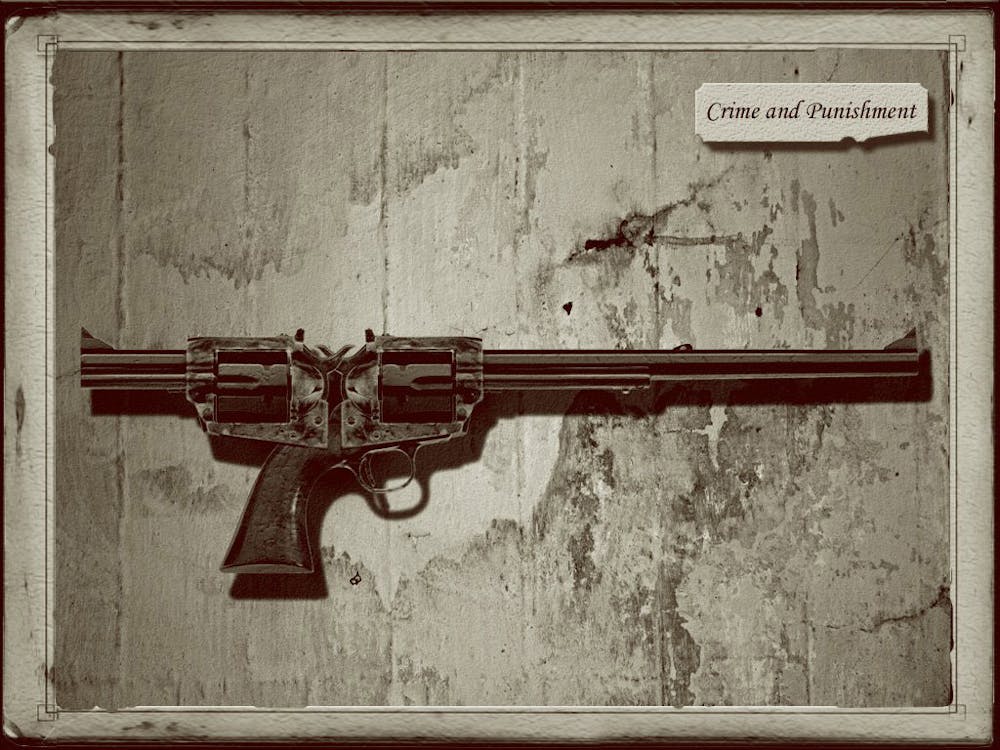In the epilogue of Norton Critical Edition’s 2018 translation of Fyodor Dostoevsky’s Crime and Punishment, the main character, Rodion Raskolnikov, has a feverish dream in which its events foreshadow the tumult of 2021. The novel is based around Raskolnikov’s journey as an impoverished ex-student and rising sociopath who plans on killing a pawnbroker for her money. As Raskolnikov’s pride and clashing morals alienate him from society, the reader is taken through his confusing yet murderous schemes and mental decline, until he falls ill. Here, the prophecy of 2021 begins.
Raskolnikov’s hysterical condition worsens upon beginning his prison sentence, causing him to have a dream about the spread of nihilism in the form of a virus. The events chronicled in this dream are extremely telling of dual pandemics — the global COVID-19 outbreak and the dissemination of disinformation through social media — that plagued 2020 and now plague 2021.
The parallels between COVID-19 and the infection in Raskolnikov’s dream are overtly apparent. Dostoevsky’s narration of the dream maps the transmission of the virus from the Eastern Hemisphere to the Western Hemisphere, describing it as “some terrible, previously unknown pestilence, which was moving toward Europe out of the depths of Asia.”
The COVID-19 pandemic has eerily mirrored this route, originating in China, then spreading across Europe and almost every corner of the world. Furthermore, both are highly lethal and contagious diseases. Raskolnikov envisioned that “everyone would perish except for a chosen few,” and that the illness would propagate throughout “whole populations.” Though millions have recovered from COVID-19, the death toll has surpassed 2,000,000, making it one of the most fatal infectious diseases ever encountered in human history.
These correlations between Dostoevsky’s account of the fictitious disease and the contemporary state of affairs are shockingly accurate. Though it is likely that the similarities between this fictitious passage and the modern COVID-19 situation are simply coincidental, it is important to highlight the fact that Dostoevsky was able to identify and foresee the trajectory on which the world was moving — that of globalization.
Dostoevsky’s choice of an imaginary virus as his metaphoric device to explore the implications of this phenomenon becomes all the more harrowing when paired with the spread of false information. The reaction to the illness portrayed in Raskolnikov’s dream proves extremely emblematic of the invasion of fake news through social media and propaganda that has become so prevalent in 2021. In his dream, Raskolnikov recalls how the symptoms of the virus led to a societal collapse into “senseless delirium.”
On an even scarier note, those who were infected in the novel became “possessed and insane” by the belief that “their pronouncements, their scientific conclusions, [and] their moral convictions” were “infallible.” In other words, the disease caused them to become self-centered individuals who considered themselves to always be absolutely correct in everything they said, did or believed, that they could not understand one another and therefore were unable to agree on what “constituted good and evil.”
The dissonance between individuals and groups reaches a climax as people begin acting out; Dostoevsky recounts community gatherings called by blaring alarms for no apparent reason, which led to baseless accusations, violent “slaughter” and “famine,“ all of which mount into an overwhelming “anxiety.” Dostoevsky summarizes this crisis in one brutal sentence: “Nearly everything and everyone perished.”
Dostoevsky feared that the spread of nihilistic ideology would cause insanity by allowing everyone to view themselves as the sole possessor of the truth. Yet in both 2020 and 2021, it is not the doctrine of nihilism that has induced this shift, but rather, contemporary society’s use of social media and disinformation to further elongate the distance between the peoples of our nation. In light of recent events outside of the pandemic, specifically the storming of the U.S. Capitol by avid Trump supporters, the depiction of the epidemic in Raskolnikov’s dream presents a dark reflection of the events that have transpired today.
Social media, though many people’s primary source of news, has become a dangerously abused platform by aggressors. Trump supporters used social media sites, including Gab and Parler, as online drawing boards to organize their attack on the Capitol to disrupt Congress from certifying President Joe Biden’s victory. This historic incident showed us that such a blatant incursion against American democracy could occur on federal ground and truly marked a dark day for humanity. This is something that Dostoevsky foreshadowed a little bit too accurately in the novel.
Ultimately, I believe that Raskolnikov’s prophetic dream can and should be heeded as a wake-up call to current society. It seems we as a species have developed the perfect set of technological tools and polarized political climate to spiral into the kind of catastrophe that Dostoevsky predicts. To avoid this ominous fate, we need to re-dedicate ourselves to a collective understanding of reality, and not just any reality, but one rooted in an empathetic understanding of the common good that will lead our progress in the right direction.
This novel perfectly encapsulates the disinformation crisis and recommends several countermeasures to protect ourselves against social media and each other. If Raskolnikov, whose moral compass is just as broken as that of the civilization of 2021, can redeem himself and overcome his wrongdoings, I believe that there is hope for us yet.





